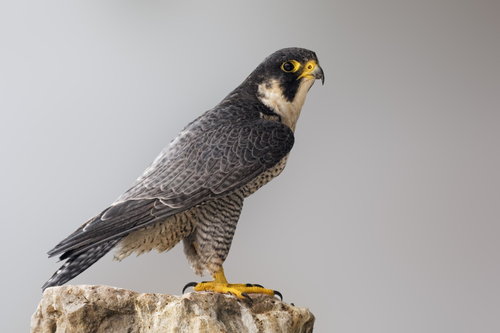
Written: Sahil
The Peregrine Falcon(Falco peregrinus) is a medium sized bird of prey (raptor). It is also known as a Duck Hawk in North America. The Peregrine Falcon is renowned for its speed. During its characteristic hunting stoop, it can reach speed of up to 320 km/h (200 mph/h), making it the fastest not only among birds but in the whole animal kingdom. Its diet mainly consists of medium sized birds like pigeons, starlings and doves, but occasionally it goes for small mammals too.
Description
The Peregrine Falcon is a medium sized raptor. It has a typical body length of 34-58 cm (13-23 in). Both male and female Peregrine Falcons have similar plumage and markings. Peregrine Falcons show sexual dimorphism. Females can measure up to 30% larger than their male counterparts. Males weigh between 300 to 1000 g (0.73-2.2 lb) while the much larger females weigh between 700 to 1500 g (1.5-3.3 lb). the back and the long pointed wings of adult Peregrine Falcons are bluish black to slate grey with darker barring. The underparts are white to rusty with black bars or dots. The tail is also colored like the back and is narrow and rounded at the end. There is a white band at the very end of the tail. The top of the head is black. There is a black lining resembling a moustache along the cheeks. The neck is usually pale and white throat. The cere and the feet both are yellow while the beak and claws are black. The upper beak has a notch near the tip that is known as a tooth which enables falcons to kill their prey. The immature bird is much browner with streaked, rather than barred, underparts, and has a pale bluish cere and orbital ring.
Habitat
The Peregrine Falcon is found all over the world except New Zeeland. It is usually found along the lake edges, coastlines, mountain ranges and now increasingly in cities. Those living in regions with mild winters don’t migrate and adult males will remain in the breeding territory. Only the population living in the cold arctic climate will migrate in the harsh winter. They are named “peregrine “which means “wanderer “or “pilgrim “due to their migrating behaviour. In north America they breed in open landscapes with cliffs or skyscrapers for nest sites. They can be found nesting at elevations up to about 12,000 feet, as well as along rivers and coastlines or in cities, where the local rock pigeon populations offer a reliable food supply. In migration and winter, you can find Peregrine Falcons in nearly any open habitat, but with a greater likelihood along barrier islands, mudflats, coastlines, lake edges, and mountain chains.
Diet and Behaviour
The Peregrine Falcon feeds almost exclusively on birds. The bird species on which Peregrine Falcons prey on is very varied and enormous. These include doves, waterfowl, songbirds and waders to name a few. Its prey species also very greatly in size, from hummingbirds to the sandhill crane. Peregrine Falcons also eat a substantial number of bats. They occasionally pirate prey from other birds of prey.
The Peregrine Falcon hunts at dawn and dusk when the prey is most active. But nocturnally in cities especially during the migration periods. Nocturnal migrants taken by Peregrines include species as diverse as the Yellow-Billed Cuckoo(Coccyzus americanus), Black-Necked Grebe(Podiceps nigricollis), Virginia Rail(Rallus limicola), and Common Quail(Coturnix coturnix). The Peregrine Falcon needs open space for hunting, therefore it hunts usually over marshes, valleys, fields and tundras. When hunting, Peregrine Falcons start by watching from a high perch or by flapping slowly or soaring at great heights. Stoops begin 300–3,000 feet above their prey and end either by the Peregrine Falcon grabbing the prey or by striking it with the feet hard enough to stun or kill it.
Peregrine Falcons do have other hunting methods, including level pursuit, picking birds out of large flocks, and occasionally even hunting on the ground. Though the Peregrine Falcon is an elite predator, it does have its own predators, including gyrfalcons, eagles, and the Great-Horned Owl(Bubo virginianus).
Reproduction
The Peregrine Falcon reaches sexual maturity at one to three years of age. A pair mates for life and returns to the same nesting spot annually. During the breeding season, they are territorial and usually nesting pairs are more than 1 km apart. This ensures that their chicks get enough food. Generally, three to four eggs are laid. The eggs are white to buff with brown or red markings.
Usually it’s the female who incubates the eggs. Eggs are hatched after 29-33 days of laying the eggs. The hatchlings are covered in creamy-white down. Male and female Peregrine Falcons leave the nest to hunt and feed their chicks. Chicks fledge 42 to 46 days after hatching and remain dependent on their parents for up to two months.
Sahil is a freelance writer who does not necessarily share the opinions expressed on BrantaMedia.com.
